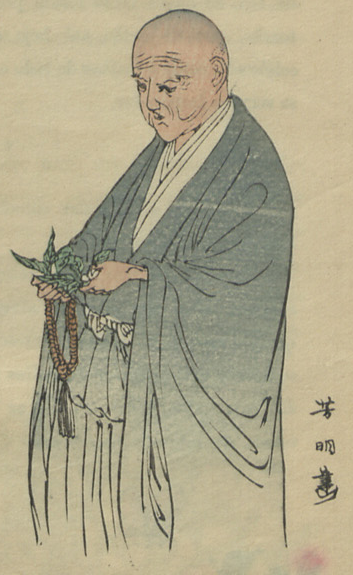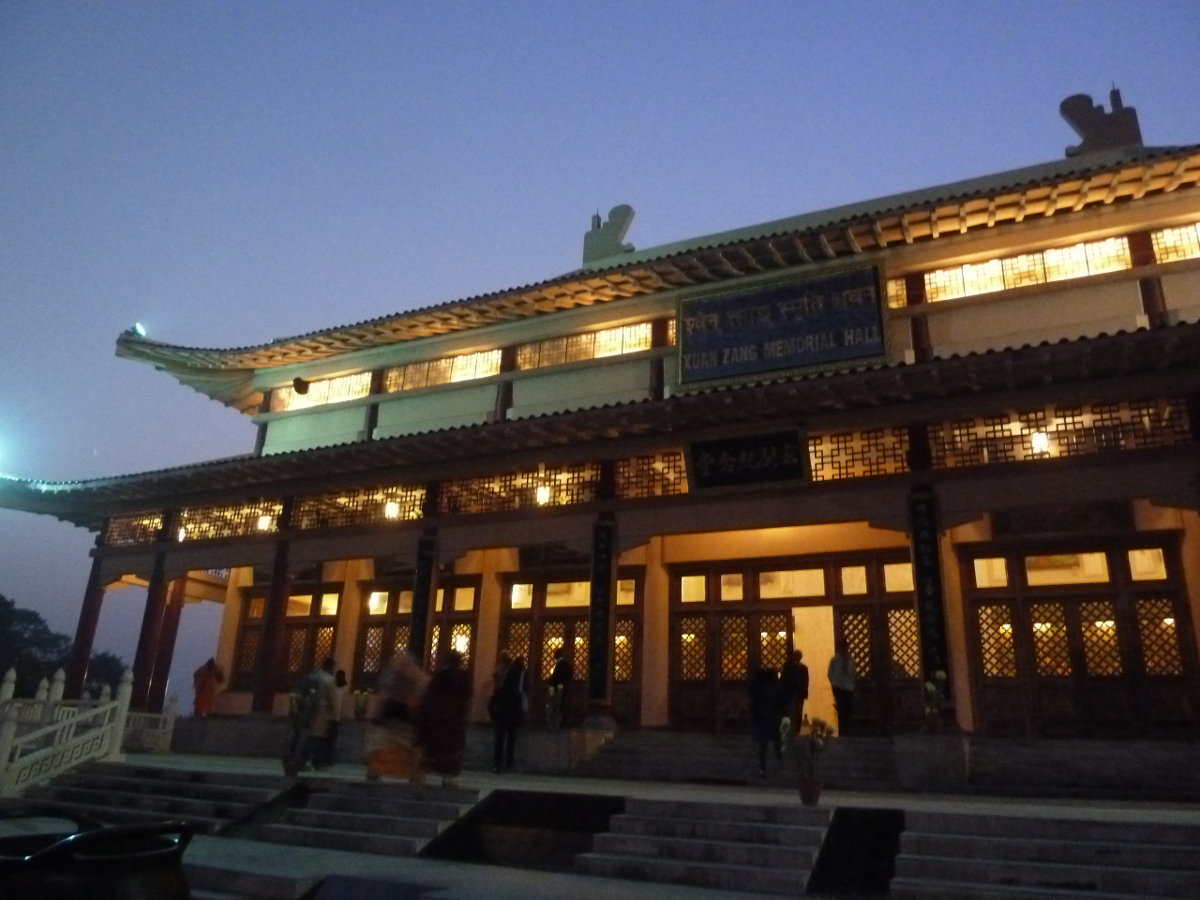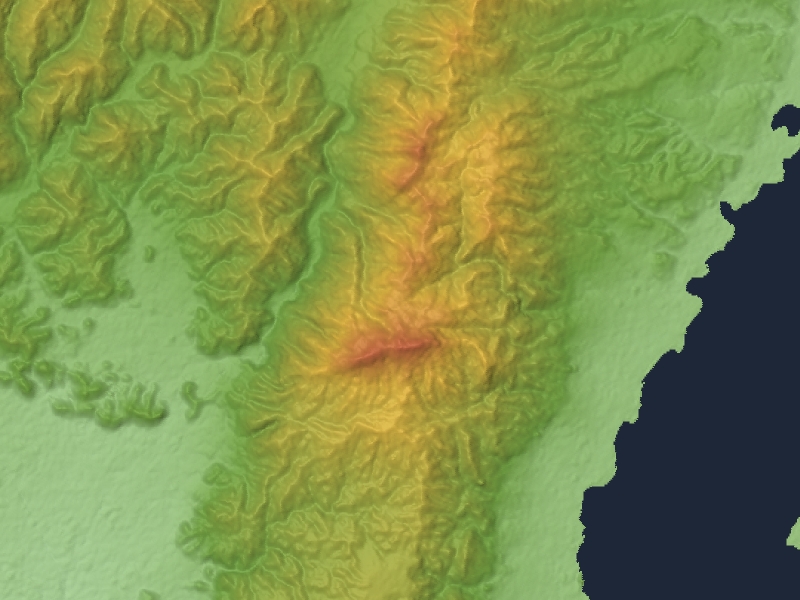|
Saichō
was a Japanese Buddhist monk credited with founding the Tendai school of Buddhism based on the Chinese Tiantai school he was exposed to during his trip to Tang China beginning in 804. He founded the temple and headquarters of Tendai at Enryaku-ji on Mount Hiei near Kyoto. He is also said to have been the first to bring tea to Japan. After his death, he was awarded the posthumous title of Dengyō Daishi (伝教大師). Life Early life Saichō was born in the year 767 in the city of Ōmi, in present Shiga Prefecture, with the given name of Hirono. According to family tradition, Saichō's ancestors were descendants of emperors of Eastern Han China; however, no positive evidence exists for this claim. The region where Saichō was born did have a large Chinese immigrant population, so Saichō likely did have Chinese ancestry. During Saichō's time, the Buddhist temples in Japan were officially organized into a national network known as the provincial temple system, and at the ... [...More Info...] [...Related Items...] OR: [Wikipedia] [Google] [Baidu] |
Tendai
, also known as the Tendai Lotus School (天台法華宗 ''Tendai hokke shū,'' sometimes just "''hokke shū''") is a Mahāyāna Buddhist tradition (with significant esoteric elements) officially established in Japan in 806 by the Japanese monk Saichō ( posthumously known as Dengyō Daishi). The Tendai school, which has been based on Mount Hiei since its inception, rose to prominence during the Heian period (794-1185). It gradually eclipsed the powerful ''Hossō'' school and competed with the rival Shingon school to become the most influential sect at the Imperial court. By the Kamakura period (1185-1333), Tendai had become one of the dominant forms of Japanese Buddhism, with numerous temples and vast landholdings. During the Kamakura period, various monks left Tendai (seeing it as corrupt) to establish their own "new" or "Kamakura" Buddhist schools such as Jōdo-shū, Nichiren-shū and Sōtō Zen. The destruction of the head temple of Enryaku-ji by Oda Nobunaga in 1571, ... [...More Info...] [...Related Items...] OR: [Wikipedia] [Google] [Baidu] |
History Of Tea In Japan
The history of tea in Japan began as early as the 8th century, when the first known references were made in Japanese records. Tea became a drink of the religious classes in Japan when Japanese priests and envoys sent to China to learn about its culture brought tea to Japan. The Buddhist monks Kūkai and Saichō may have been the first to bring tea seeds to Japan. The first form of tea brought from China was probably brick tea. Tea became a drink of the royal classes when Emperor Saga encouraged the growth of tea plants. Seeds were imported from China, and cultivation in Japan began. Tea consumption became popular among the gentry during the 12th century, after the publication of Eisai's ''Kissa Yōjōki''. Uji, with its strategic location near the capital at Kyoto, became Japan's first major tea-producing region during this period. Beginning in the 13th and 14th centuries, Japanese tea culture developed the distinctive features for which it is known today, and the Japanese tea ce ... [...More Info...] [...Related Items...] OR: [Wikipedia] [Google] [Baidu] |
Enryaku-ji
is a Tendai monastery located on Mount Hiei in Ōtsu, overlooking Kyoto. It was first founded in 788 during the early Heian period (794–1185) by Saichō was a Japanese Buddhist monk credited with founding the Tendai school of Buddhism based on the Chinese Tiantai school he was exposed to during his trip to Tang China beginning in 804. He founded the temple and headquarters of Tendai at Enryaku-j ... (767–822), also known as Dengyō Daishi, who introduced the Tendai sect of Mahayana Buddhism to Japan from China. The temple complex has undergone several reconstruction efforts since then, with the most significant (that of the main hall) taking place in 1642 under Tokugawa Iemitsu. Enryaku-ji is the headquarters of the Tendai sect and one of the most significant monasteries in Japanese history. As such, it is part of the UNESCO World Heritage Site "Historic Monuments of Ancient Kyoto (Kyoto, Uji and Otsu Cities)". The founders of Jōdo-shū, Jōdo Shinshū, Sōtō, Sōt� ... [...More Info...] [...Related Items...] OR: [Wikipedia] [Google] [Baidu] |
East Asian Yogācāra
East Asian Yogācāra (, "'Consciousness Only' school" or , "'Dharma Characteristics' school") refers to the traditions in East Asia which developed out of the Indian Buddhist Yogachara systems. The 4th-century Gandharan brothers, Asaṅga and Vasubandhu, are considered the classic philosophers and systematizers of this school, along with its other founder, Maitreya-natha.Siderits, Mark, ''Buddhism as philosophy'', 2017, p. 146. Asian Buddhist scholars such as Xuanzang and his students Kuiji, Woncheuk and Dōshō were also pivotal to the founding and development of the tradition in East Asia. Etymology The term ''Fǎxiàng'' itself was first applied to this tradition by the Huayan teacher Fazang ( zh, 法藏), who used it to characterize Consciousness Only teachings as provisional, dealing with the phenomenal appearances of the dharmas. Chinese proponents preferred the title ''Wéishí'' (), meaning "Consciousness Only" (Sanskrit ''Vijñaptimātra''). This school may also be ... [...More Info...] [...Related Items...] OR: [Wikipedia] [Google] [Baidu] |
Japanese Missions To Imperial China
The Japanese missions to Imperial China were diplomatic embassies which were intermittently sent to the Chinese imperial court. Any distinction amongst diplomatic envoys sent from the Japanese court or from any of the Japanese shogunates was lost or rendered moot when the ambassador was received in the Chinese capital. Extant records document missions to China between the years of 607 and 839 (a mission planned for 894 was cancelled). The composition of these imperial missions included members of the aristocratic ''kuge'' and Buddhist monks. These missions led to the importation of Chinese culture, including advances in the sciences and technology. These diplomatic encounters produced the beginnings of a range of schools of Buddhism in Japan, including Zen. From the Sinocentric perspective of the Chinese court in Chang'an, the several embassies sent from Kyoto were construed as tributaries of Imperial China; but it is not clear that the Japanese shared this view. China seems ... [...More Info...] [...Related Items...] OR: [Wikipedia] [Google] [Baidu] |
Bodhisattva Precepts
The Bodhisattva Precepts ( Skt. ''bodhisattva-śīla'', , ja, bosatsukai) are a set of ethical trainings ('' śīla'') used in Mahāyāna Buddhism to advance a practitioner along the path to becoming a bodhisattva. Traditionally, monastics observed the basic moral code in Buddhism, the prātimokṣa (such as that of the Dharmaguptaka), but in the Mahāyāna tradition, monks may observe the Bodhisattva Precepts as well. The Bodhisattva Precepts are associated with the bodhisattva vow to save all beings and with bodhicitta. Sets of Precepts ''Brahmajāla Sūtra'' The ''Brahmajāla Sūtra'', translated by Kumārajīva (c. 400 CE), has a list of ten major and forty-eight minor Bodhisattva vows. The Bodhisattva Precepts may be often called the "Brahma Net Precepts" (), particularly in Buddhist scholarship, although other sets of bodhisattva precepts may be found in other texts as well. Typically, in East Asian Mahāyāna traditions, only the ten major precepts are considered ... [...More Info...] [...Related Items...] OR: [Wikipedia] [Google] [Baidu] |
Tiantai
Tiantai or T'ien-t'ai () is an East Asian Buddhist school of Mahāyāna Buddhism that developed in 6th-century China. The school emphasizes the ''Lotus Sutra's'' doctrine of the "One Vehicle" (''Ekayāna'') as well as Mādhyamaka philosophy, particularly as articulated in the works of the fourth patriarch Zhiyi (538–597 CE). Brook Ziporyn states that Tiantai is "the earliest attempt at a thoroughgoing Sinitic reworking of the Indian Buddhist tradition." According to Paul Swanson, Tiantai Buddhism grew to become "one of the most influential Buddhist traditions in China and Japan." The name of the school is derived from the fact that Zhiyi lived on Tiantai Mountain (Tiantai means "platform of the sky"), which then became a major center for the tradition. Zhiyi is also regarded as the first major figure to form an indigenous Chinese Buddhist system. Tiantai is sometimes also called "The Lotus School", after the central role of the ''Lotus Sutra'' in its teachings. During the ... [...More Info...] [...Related Items...] OR: [Wikipedia] [Google] [Baidu] |
Bhikkhu
A ''bhikkhu'' (Pali: भिक्खु, Sanskrit: भिक्षु, ''bhikṣu'') is an ordained male in Buddhist monasticism. Male and female monastics ("nun", ''bhikkhunī'', Sanskrit ''bhikṣuṇī'') are members of the Sangha (Buddhist community). The lives of all Buddhist monastics are governed by a set of rules called the prātimokṣa or pātimokkha. Their lifestyles are shaped to support their spiritual practice: to live a simple and meditative life and attain nirvana. A person under the age of 20 cannot be ordained as a bhikkhu or bhikkhuni but can be ordained as a śrāmaṇera or śrāmaṇērī. Definition ''Bhikkhu'' literally means "beggar" or "one who lives by alms". The historical Buddha, Prince Siddhartha, having abandoned a life of pleasure and status, lived as an alms mendicant as part of his śramaṇa lifestyle. Those of his more serious students who renounced their lives as householders and came to study full-time under his supervision also adopte ... [...More Info...] [...Related Items...] OR: [Wikipedia] [Google] [Baidu] |
Mount Hiei
is a mountain to the northeast of Kyoto, lying on the border between the Kyoto and Shiga Prefectures, Japan. The temple of Enryaku-ji, the first outpost of the Japanese Tendai (Chin. Tiantai) sect of Buddhism, was founded atop Mount Hiei by Saichō in 788 and rapidly grew into a sprawling complex of temples and buildings that were roughly divided into three areas: # The area near the summit, and technically in Kyoto Prefecture. # The area, also near the summit, where Enryaku-ji Temple was first founded, and located just within Shiga Prefecture. # The area near the northernmost end of Mount Hiei. Due to its remoteness, as a temple complex it experienced periods of revival and decline, starting with Ennin, later revived by Ryōgen and made famous by the scholar-monk Genshin. Due to its position north-east of the ancient capital of Kyoto, it was thought in ancient geomancy practices to be a protective bulwark against negative influences on the capital, which along with the r ... [...More Info...] [...Related Items...] OR: [Wikipedia] [Google] [Baidu] |
Emperor Kanmu
, or Kammu, was the 50th emperor of Japan, Imperial Household Agency (''Kunaichō'') 桓武天皇 (50) retrieved 2013-8-22. according to the traditional order of succession. Kanmu reigned from 781 to 806, and it was during his reign that the scope of the emperor's powers reached its peak. Traditional narrative Kanmu's personal name (''imina'') was .Brown, p. 277 He was the eldest son of Prince Shirakabe (later known as ), and was born prior to Shirakabe's ascension to the throne. According to the , Yamabe's mother, Yamato no Niigasa (later called |
Shiga Prefecture
is a prefecture of Japan located in the Kansai region of Honshu. Shiga Prefecture has a population of 1,412,916 (1 October 2015) and has a geographic area of . Shiga Prefecture borders Fukui Prefecture to the north, Gifu Prefecture to the northeast, Mie Prefecture to the southeast, and Kyoto Prefecture to the west. Ōtsu is the capital and largest city of Shiga Prefecture, with other major cities including Kusatsu, Nagahama, and Higashiōmi. Shiga Prefecture encircles Lake Biwa, the largest freshwater lake in Japan, and 37% of the total land area is designated as Natural Parks, the highest of any prefecture. Shiga Prefecture's southern half is located adjacent to the former capital city of Kyoto and forms part of Greater Kyoto, the fourth-largest metropolitan area in Japan. Shiga Prefecture is home to Ōmi beef, the Eight Views of Ōmi, and Hikone Castle, one of four national treasure castles in Japan. History Shiga was known as Ōmi Province or Gōshū before the pref ... [...More Info...] [...Related Items...] OR: [Wikipedia] [Google] [Baidu] |
Tōdai-ji
is a Buddhist temple complex that was once one of the powerful Nanto Shichi Daiji, Seven Great Temples, located in the city of Nara, Nara, Nara, Japan. Though it was originally founded in the year 738 CE, Tōdai-ji was not opened until the year 752 CE. The temple has undergone several reconstructions since then, with the most significant reconstruction (that of the Great Buddha Hall) taking place in 1709. Its Great Buddha Hall (大仏殿 ''Daibutsuden'') houses the world's largest bronze statue of the Buddha Vairocana, known in Japanese as ''Daibutsu'' (大仏). The temple also serves as the Japanese headquarters of the Kegon school of Buddhism. The temple is a listed UNESCO World Heritage Site as one of the "Historic Monuments of Ancient Nara", together with seven other sites including temples, shrines and places in the city of Nara. History Origins The beginning of building a temple where the Kinshōsen-Ji complex sits today can be dated to 728 CE, when Emperor Shōmu e ... [...More Info...] [...Related Items...] OR: [Wikipedia] [Google] [Baidu] |


.jpg)






